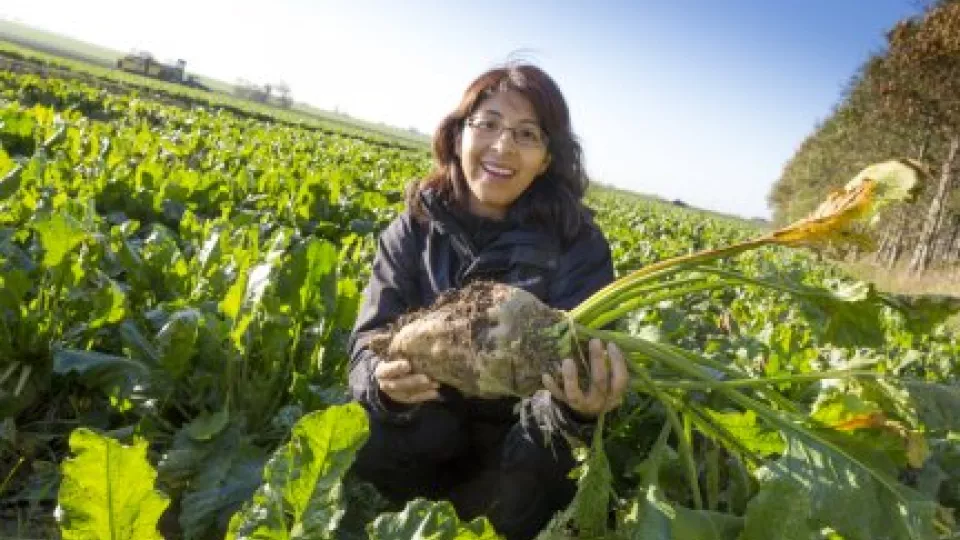Watch on YouTube: How to produce haemoglobin from sugar beets
“Previously, it has been presumed that certain plants produce this iron protein only when stressed, such as in drought or frost, because it has been seen that this is the case for certain other plants. However, we have shown that haemoglobin is produced even in a normal state”, said Nélida Leiva, a doctoral student of applied biochemistry at Lund University, who has just presented the findings in a doctoral thesis.
Nélida Leiva’s supervisor, Professor Leif Bülow, has spent many years conducting research on the production of human haemoglobin, primarily with the help of bacteria, because haemoglobin from blood donors is far from sufficient to cover the needs of society.
The process of extracting haemoglobin from sugar beets is not much more complicated than extracting sugar, according to the researchers. The challenge lies in obtaining sufficient volumes. However, Nélida Leiva and Leif Bülow believe there is good reason to think that sugar beets and other crops could become a realistic alternative.
“From one hectare, we could produce 1–2 tons of haemoglobin, which could save thousands of lives”, said Leif Bülow. The human body contains almost 1kg of haemoglobin.
In just over a year, the researchers will start testing the haemoglobin from plants in animal experiments with researchers at University College London, who have world-leading expertise on blood transfusions.
In the work on her thesis, Nélida Leiva has also discovered that the haemoglobin in sugar beet is almost identical to human haemoglobin, especially the form of haemoglobin we have in our brains.
“There is a difference in a small detail on the surface of the protein, but this simply appears to extend the lifespan of the haemoglobin from sugar beet, which is good news”, said Nélida Leiva.
But why is there haemoglobin in plants at all? They surely don’t need to transport oxygen? Nélida Leiva has discovered that the substance has a completely different function, despite its similarity to human haemoglobin.
“We have found that the haemoglobin in the plant binds nitric oxide. It is probably needed to keep certain processes in check, for example so that the nitric oxide doesn’t become toxic, and to ward off bacteria.”
In humans, there are several types of haemoglobin. The majority is of the type found in the blood, but haemoglobin is also present in the testicles and the brain. It is the haemoglobin in the brain that is most like that in sugar beets. Nélida Leiva has not only discovered haemoglobin in the sugar beet root, but also in the leaves and flowers.
Haemoglobin as a blood substitute
Following an accident, it is important that additional haemoglobin is quickly supplied to the patient so that oxygen can be transported around the body – the main task of haemoglobin. Haemoglobin (Hb) is needed in the initial period up to five hours after an accident. After this, complete blood must be given.
Besides human donations and waste from abattoirs, bacteria-cultivated haemoglobin is the method we have available to create a stock of the vital iron proteins.
In some countries, such as China and India, blood banks are non-existent or very limited, which means that alternatives must be developed quickly. It is especially important to get hold of these substitutes in emergency situations where safe blood transfusions are of vital importance, according to Leif Bülow.
“The Ebola epidemic in Africa is a current example where these blood substitutes could save lives”, he added.
Thesis: Biochemical and Physiological Characterization of Nonsymbiotic Plant Hemoglobins – lu.se
Publication: Differential Expression Patterns of Non-Symbiotic Hemoglobins in Sugar Beet (Beta vulgaris ssp. vulgaris)
Contact:
Leif Bülow, Professor of Applied Biochemistry, Lund University, ++46 707 102917, leif [dot] bulow [at] tbiokem [dot] lth [dot] se (leif[dot]bulow[at]tbiokem[dot]lth[dot]se)
Nélida Leiva, doctoral student in Applied Biochemistry, +46 46 222 82 59 nelida [dot] leiva [at] tbiokem [dot] lth [dot] se (nelida[dot]leiva[at]tbiokem[dot]lth[dot]se)
